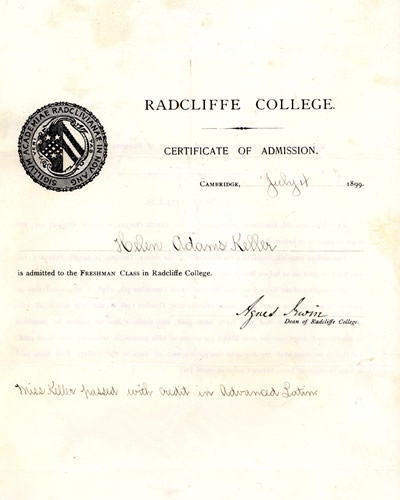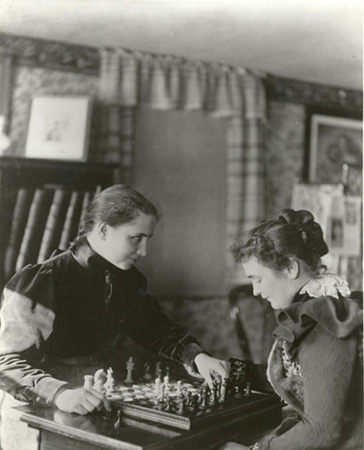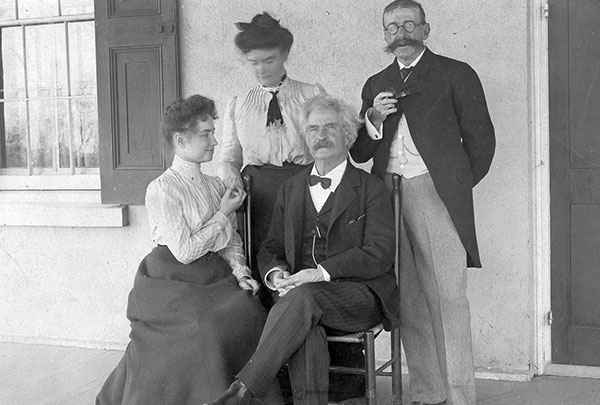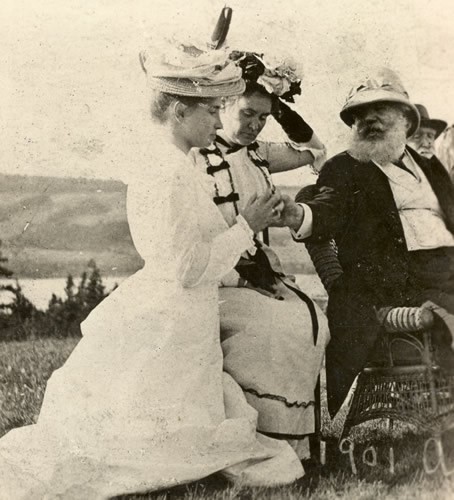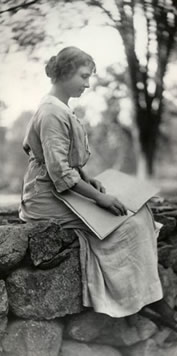This is the first graduating class of the Wright-Humason School for the Deaf in New York City. Taken in 1895, it shows the group of students kneeling, standing, and sitting together on a fancy rug. Fourteen of the 21 students are female. Helen is sitting on the far left, holding Anne's hand. All of the women are wearing dark, Victorian-style dresses that are puffy in the chest and shoulders, then tight in the waist and forearms. The men have on jackets, vests and neckties. There is one incredibly young graduate, who is probably in the third or fourth grade. He is sitting patiently on the rug, wearing a white shirt with a huge collar, and a dark jacket, and pants.
When Helen was 13, Helen and Anne moved to New York City. There Helen attended the Wright-Humason school for the deaf. She was the only student who was deaf and blind. In class, Anne read everything and signed what she read into Helen's hand. Helen devoured information and became able to communicate with other adults and children. She was even learning how to speak.
Nowadays, colleges just send out acceptance letters, but many years ago, they used to give out certificates of admission. Here is the one Radcliffe College sent Helen in 1899. It has a handwritten note saying, "Miss Keller passed with credit in advanced Latin."
In 1896, Helen went to the Cambridge School for Young Ladies, run by Arthur Gilman. Attending his school helped Helen prepare for her college entrance examinations. She was admitted to Radcliffe College in 1899. Radcliffe was the sister college to Harvard University, which at the time did not allow women to attend.
In this picture, taken in 1900, Helen and Anne are playing chess. Helen is about to move a white queen. She has already captured one of Anne's black pawns, which is to the right of the board. Helen's hair is pulled into a single braid, down her back. She is wearing a long, dark dress with a high collar and sleeves that puff out from the shoulder to the elbow. Anne's hair is twisted almost like a flower, at the back of her head. She is wearing a dark dress with a white lace collar and dark ruffles around each shoulder.
Anne Sullivan (Helen always called her "Teacher") was very dedicated to Helen. And Helen loved to learn about everything. She studied French, German, and Latin. She learned to play chess and to horseback ride. Since many books were not available in braille at that time, Anne would sign what she read into Helen's hand.
This faded photograph, from 1902, shows four people on a sunny front porch. Helen is seated on the far left, smiling, while Anne stands behind her, signing into her hand. To their right is Mark Twain, sitting with his hands folded in his lap, and Laurence Hutton, who is standing behind Twain and holding a cigar. Hutton was Literary Editor of Harper's magazine and a supporter of Helen's education.
Helen met a lot of famous people, including Mark Twain, the author of Tom Sawyer and The Adventures of Huckleberry Finn. Twain was great friends with Helen, and he signed his letters to Helen with his real name, Samuel L. Clemens.
In this scenic photo, Anne and Helen are up on a hilltop, with a river and more hills behind them. (They may be at Alexander Graham Bell's summer home in Nova Scotia, Canada.) Helen is on the left, kneeling next to Anne and Bell, who are seated. Everyone is wearing hats. Helen's straw hat has a spiral of sheer fabric on top and a big dark feather sticking straight up. Anne wears a hat with huge flowers and a white dress with black ribbon trim and elbow-length gloves; she has one hand on her hat and the other hand in Helen's. Bell is sitting on a wicker chair, facing Helen, wearing a jungle explorer-type hat called a pith helmet. His right hand is outstretched to Helen's right hand, and he seems to be communicating with her using the manual alphabet. Behind Bell is another man, possibly John Hitz of the Volta Bureau, wearing a bowler hat.
Helen was also good friends with Alexander Graham Bell, who invented the telephone. Bell was very interested in education for the hearing impaired, in part because his wife Mabel was deaf. In 1888 Bell founded the Volta Bureau for the Deaf, which is now called the Alexander Graham Bell Association for the Deaf. Bell was a good friend of Helen and Anne's and would remain so until his death in 1922. In this picture, he is talking to Helen using the manual alphabet.
This picture shows Helen seated on an old stone wall with a large Braille book in her lap. She is sitting straight up, with her legs crossed, reading the left-hand page. Her dress is simpler, less heavy, and lighter in color than her outfits in other pictures. Behind her is a meadow with many trees shaking in the wind.
In 1902, a year before her graduation, Helen successfully published her first book, The Story of My Life. John Macy, an editor and instructor at Harvard University, edited the book, and Helen dedicated it to Alexander Graham Bell, who had helped so much with her education. The book received great reviews, including one from Mark Twain. (In a letter to Helen, Twain also referred to the plagiarism scandal that took place 12 years before.) Since the book was first published, it has been translated into 50 languages!
This photograph, taken in 1904, shows Helen crouched on the floor behind her dog, a bull terrier. The dog is lying down, but its head is facing the camera. Helen's left hand is on an open braille book and her right hand is on the dog's back. She is wearing a light-colored dress with full, pleated sleeves and a big bow at the collar. The skirt has a few horizontal ruffles, made out of the same fabric.
Helen was amazing! Her actions led the way for so many women, as well as people with disabilities. In 1904, she was the first deaf-blind person to receive a college degree. She graduated from Radcliffe College cum laude, which means with very high honors.

